I hope you're ready for a picture bonanza, because this month's Daring Baker's Challenge was a doozy. I worked on it over the course of about 4 days and that's because this month's challenge was Lasagna! That's right. Homemade, handstreched pasta-old Italian grandma style.
The March 2009 challenge is hosted by Mary of Beans and Caviar, Melinda of Melbourne Larder and Enza of Io Da Grande. They have chosen Lasagne of Emilia-Romagna from The Splendid Table by Lynne Rossetto Kasper as the challenge.
But before I could get my hands doughy, I had to make the ragu. We were given the option of using our own ragu recipe, as long as we posted the recipe and I'm happy to say that this recipe is tried and true. It hails from The Traveler's Lunchbox and I've made it twice now with similar happy results.
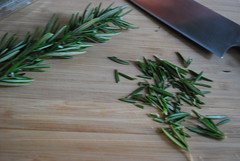
Starting off with some fresh rosemary.
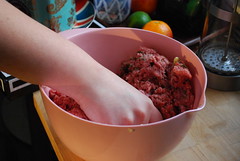
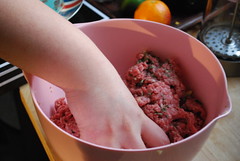
Mix it into the meat along with some diced garlic, salt and pepper.
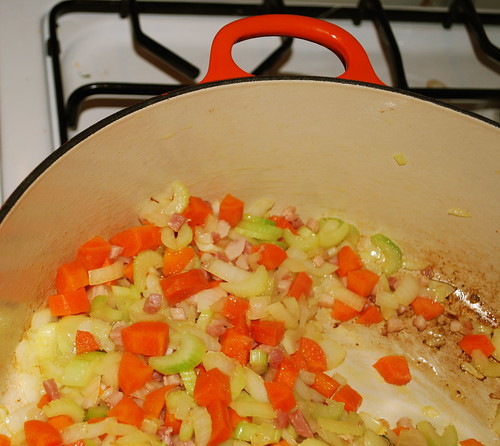
Cook up some pancetta, carrots, celery and onion until they turn golden brown

Add in the meat and brown it.
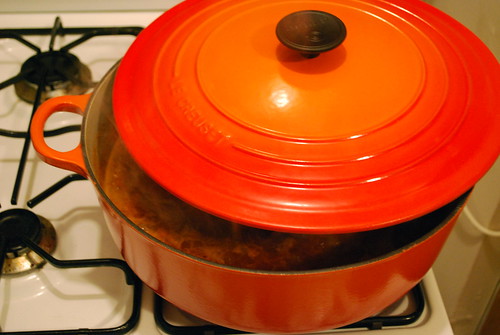
Add the wine, stock and bay leaf and cook on LOW for 2 t0 3 hours.
Now- onto the pasta!!
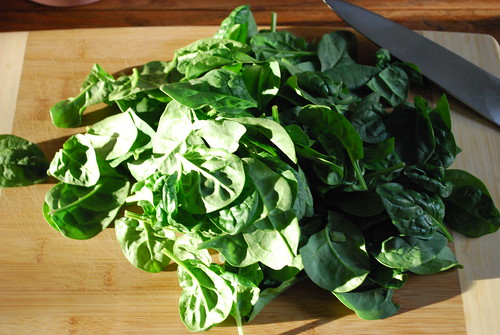
giant pile fresh leafy spinach

Chop. Chop. Chop.
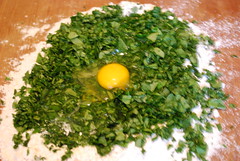
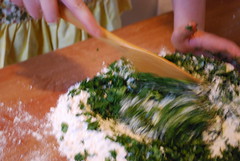

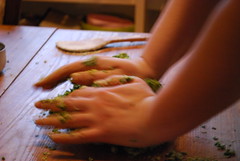
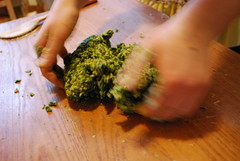
Aaaaaaaand.... TADA!
 Pasta Dough!
Pasta Dough! 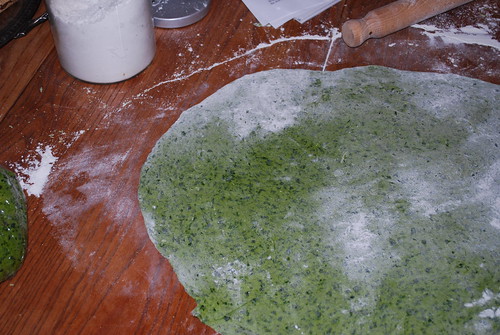
After the dough rests for at least 30 minutes, it's time to roll out that bad boy.
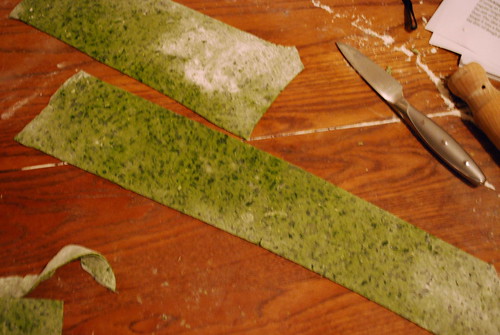
Then cut it to size
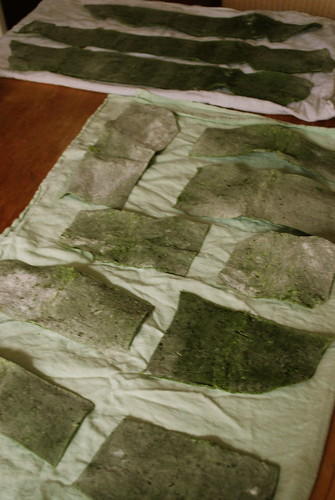
And let it out to dry

I didn't take pictures of the process of making the Bechamel Sauce but you can see that (sorta) with the Croque Monsieur recipe. So here we have a huge pot of salter water boiling away for the pasta. The bechamel has been made and is being kept warm on the hob and the ragu has been reheated.
Now, because I was kinda freaking during the making-of-the-lasagna (and maybe because by then it was dark on day 4) I didn't manage to take any pictures... and because the stuff was so delicious, I didn't take pictures of the finished product either... *SHAME* i know. No- wait! I DID take one picture of my bowl right before I ate it but it was really more of an afterthought and it was dark out and it made the lasagna look like dog food.. so I'll spare you that. Instead, why don't you head on over to see what the other Daring Bakers cooked up this month! I'm sure they pictures aplenty to satiate your need for lasagna photography. And if you're feeling brave- here are all the recipes:
All recipes below from The Splendid Table: Recipes from Emilia-Romagna, the Heartland of Northern Italian Food by Lynne Rossetto Kasper (published by William Morrow and Company Inc., 1992).
Lasagne of Emilia-Romagna (Lasagne Verdi al Forno)
(Serves 8 to 10 as a first course, 6 to 8 as a main dish)
Preparation Time: 15 minutes to assemble and 40 minutes cooking time
Preparation Time: 15 minutes to assemble and 40 minutes cooking time
10 quarts (9 litres) salted water
1 recipe Spinach Pasta cut for lasagna (recipe follows) #1
1 recipe Bechamel Sauce (recipe follows) #2
1 recipe Ragu Bolognese (recipe follows) #3
1 cup (4 ounces/125g) freshly grated Parmigiano-Reggiano
Working Ahead:
The ragu and the béchamel sauce can be made up to three days ahead. The ragu can also be frozen for up to one month. The pasta can be rolled out, cut and dried up to 24 hours before cooking. The assembled lasagne can wait at room temperature (20 degrees Celsius/68 degrees Fahrenheit) about 1 hour before baking. Do not refrigerate it before baking, as the topping of béchamel and cheese will overcook by the time the center is hot.
Assembling the Ingredients:
Have all the sauces, rewarmed gently over a medium heat, and the pasta at hand. Have a large perforated skimmer and a large bowl of cold water next to the stove. Spread a double thickness of paper towels over a large counter space. Preheat the oven to 350 degrees Fahrenheit (180 degrees Celsius). Oil or butter a 3 quart (approx 3 litre) shallow baking dish.
Cooking the Pasta:
Bring the salted water to a boil. Drop about four pieces of pasta in the water at a time. Cook about 2 minutes. If you are using dried pasta, cook about 4 minutes, taste, and cook longer if necessary. The pasta will continue cooking during baking, so make sure it is only barely tender. Lift the lasagne from the water with a skimmer, drain, and then slip into the bowl of cold water to stop cooking. When cool, lift out and dry on the paper towels. Repeat until all the pasta is cooked.
Assembling the Lasagne:
Spread a thin layer of béchamel over the bottom of the baking dish. Arrange a layer of about four overlapping sheets of pasta over the béchamel. Spread a thin layer of béchamel (about 3 or 4 spoonfuls) over the pasta, and then an equally thin layer of the ragu. Sprinkle with about 1&1/2 tablespoons of the béchamel and about 1/3 cup of the cheese. Repeat the layers until all ingredients are used, finishing with béchamel sauce and topping with a generous dusting of cheese.
Baking and Serving the Lasagne:
Cover the baking dish lightly with foil, taking care not to let it touch the top of the lasagne. Bake 40 minutes, or until almost heated through. Remove the foil and bake another 10 minutes, or until hot in the center (test by inserting a knife – if it comes out very warm, the dish is ready). Take care not to brown the cheese topping. It should be melted, creamy looking and barely tinged with a little gold. Turn off the oven, leave the door ajar and let the lasagne rest for about 10 minutes. Then serve. This is not a solid lasagne, but a moist one that slips a bit when it is cut and served.
#1 Spinach Egg Pasta (Pasta Verde)
Preparation: 45 minutes
Makes enough for 6 to 8 first course servings or 4 to 6 main course servings, equivalent to 1 pound (450g) dried boxed pasta.
Preparation: 45 minutes
Makes enough for 6 to 8 first course servings or 4 to 6 main course servings, equivalent to 1 pound (450g) dried boxed pasta.
- 2 jumbo eggs (2 ounces/60g or more)
- 10 ounces (300g) fresh spinach, rinsed dry, and finely chopped; or 6 ounces (170g) frozen chopped spinach, defrosted and squeezed dry
- 3&1/2 cups (14 ounces/400g) all purpose unbleached (plain) flour (organic stone ground preferred)
Mixing the dough:
Moud the flour in the center of your work surface and make a well in the middle. Add the eggs and spinach. Use a wooden spoon to beat together the eggs and spinach. Then gradually start incorporating shallow scrapings of flour from the sides of the well into the liquid. As you work more and more flour into the liquid, the well’s sides may collapse. Use a pastry scraper to keep the liquids from running off and to incorporate the last bits of flour into the dough. Don’t worry if it looks like a hopelessly rough and messy lump.
Kneading:
With the aid of the scraper to scoop up unruly pieces, start kneading the dough. Once it becomes a cohesive mass, use the scraper to remove any bits of hard flour on the work surface – these will make the dough lumpy. Knead the dough for about 3 minutes. Its consistency should be elastic and a little sticky. If it is too sticky to move easily, knead in a few more tablespoons of flour. Continue kneading about 10 minutes, or until the dough has become satiny, smooth, and very elastic. It will feel alive under your hands. Do not shortcut this step. Wrap the dough in plastic wrap, and let it relax at room temperature 30 minutes to 3 hours.
Stretching and Thinning:
If using an extra-long rolling pin work with half the dough at a time. With a regular-length rolling pin, roll out a quarter of the dough at a time and keep the rest of the dough wrapped. Lightly sprinkle a large work surface with flour. The idea is to stretch the dough rather than press down and push it. Shape it into a ball and begin rolling out to form a circle, frequently turning the disc of dough a quarter turn. As it thins outs, start rolling the disc back on the pin a quarter of the way toward the center and stretching it gently sideways by running the palms of your hands over the rolled-up dough from the center of the pin outward. Unroll, turn the disc a quarter turn, and repeat. Do twice more.
Stretch and even out the center of the disc by rolling the dough a quarter of the way back on the pin. Then gently push the rolling pin away from you with one hand while holding the sheet in place on the work surface with the other hand. Repeat three more times, turning the dough a quarter turn each time.
Repeat the two processes as the disc becomes larger and thinner. The goal is a sheet of even thickness. For lasagne, the sheet should be so thin that you can clearly see your hand through it and see colours. Cut into rectangles about 4 by 8 inches (10 x 20 cm). Note: Enza says that transparency is a crucial element of lasagne pasta and the dough should be rolled as thinly as possible. She says this is why her housekeeper has such strong arms!
Dry the pasta at room temperature and store in a sealed container or bag.
#2 Bechamel
Preparation Time: 15 minutes
Preparation Time: 15 minutes
- 4 tablespoons (2 ounces/60g) unsalted butter
- 4 tablespoons (2 ounces/60g) all purpose unbleached (plain) flour, organic stone ground preferred
- 2&2/3 cups (approx 570ml) milk
- Salt and freshly ground pepper to taste
- Freshly grated nutmeg to taste
Using a medium-sized saucepan, melt the butter over low to medium heat. Sift over the flour, whisk until smooth, and then stir (without stopping) for about 3 minutes. Whisk in the milk a little at a time and keep the mixture smooth. Bring to a slow simmer, and stir 3 to 4 minutes, or until the sauce thickens. Cook, stirring, for about 5 minutes, until the sauce thickens. Season with salt, pepper, and a hint of nutmeg.
#3 Ragu Bolognese
The recipe is from The Traveler's Lunchbox
For the meat:
- 1.5 lbs (700g) pork, or half pork and half beef (preferably organic, free-range)
- 3 large cloves garlic, crushed
- 1 tablespoon fresh rosemary, chopped1/2 teaspoon
- salt
- freshly-ground black pepper
2 tablespoons olive oil
4 oz (120g) pancetta, finely chopped - 1 large onion, finely chopped
- 1 fat carrot, peeled and diced
- 2 stalks celery, diced
- 1/2 cup (125ml) whole milk
- 1 cup (250ml) dry white wine
- 3 cups (750ml) chicken stock, preferably low-sodium (if your stock is very salty dilute it with a little water before measuring)
- 1/3 cup (80ml) tomato paste
- 1 bay leaf
- 1 tablespoon sugar
At least an hour and up to a day before starting to cook, knead together the ground meat, crushed garlic, chopped rosemary, salt and pepper. Cover and refrigerate.
In a large heavy pot over medium heat, heat the oil and add the pancetta, onions, carrot and celery. Cook, stirring frequently, until the vegetables are golden and have started to caramelize, about 25-30 minutes. Raise the heat to medium high and add the meat, breaking it up thoroughly with a fork and stirring constantly until medium brown in color, about 10 minutes. Add the milk, stirring until most of the liquid has evaporated. Add the wine, stock, tomato paste and bay leaf, stir well and bring to a boil.
Partially cover the pot, reduce the heat to low, and allow to cook at a gentle simmer for 2-3 hours. At the end of its cooking time the ragu should be juicy and thick, but not liquidy; if after two hours it still looks too wet, uncover and raise the heat slightly. Stir in the sugar, and adjust salt and pepper as needed. Keep warm.

Great job on your challenge and love the step-by-step pictures you've taken.
ReplyDeleteI'm amazed you were able to get a dough out of the ingredients as written! I kneaded mine for at least 20 minutes but it was still a huge lump. Like lots of other DB'ers, I had to add in some more liquid.
ReplyDeleteLove your photos. :)
You are so right about the dough. I would have sworn that it would NEVER come together. I thought I must have the world's driest spinach and was sorry I hadn't used frozen. Then, after what seemed like forever, it came together. Kneading it was an aerobic activity, but the end product was sublime.
ReplyDeleteMmm, your lasagne looks awesome, beautiful photos =D!
ReplyDeleteYup, same here.. I added a lot of liquids to the dough! Tasty but boy what a challenge it was. Fantastic looking lasagna.. Absolutely gorgeous
ReplyDeleteWay to go! Your lasagne looks delish! I had to double the eggs and then still add water to the pasta dough. I loved it though!! It is so fun to see other crazy people who take pictures of their food. I used to think that I was the only one in the world who did this until I joined this group. So fun!! Again- great looking lasagne!! Lisa
ReplyDelete